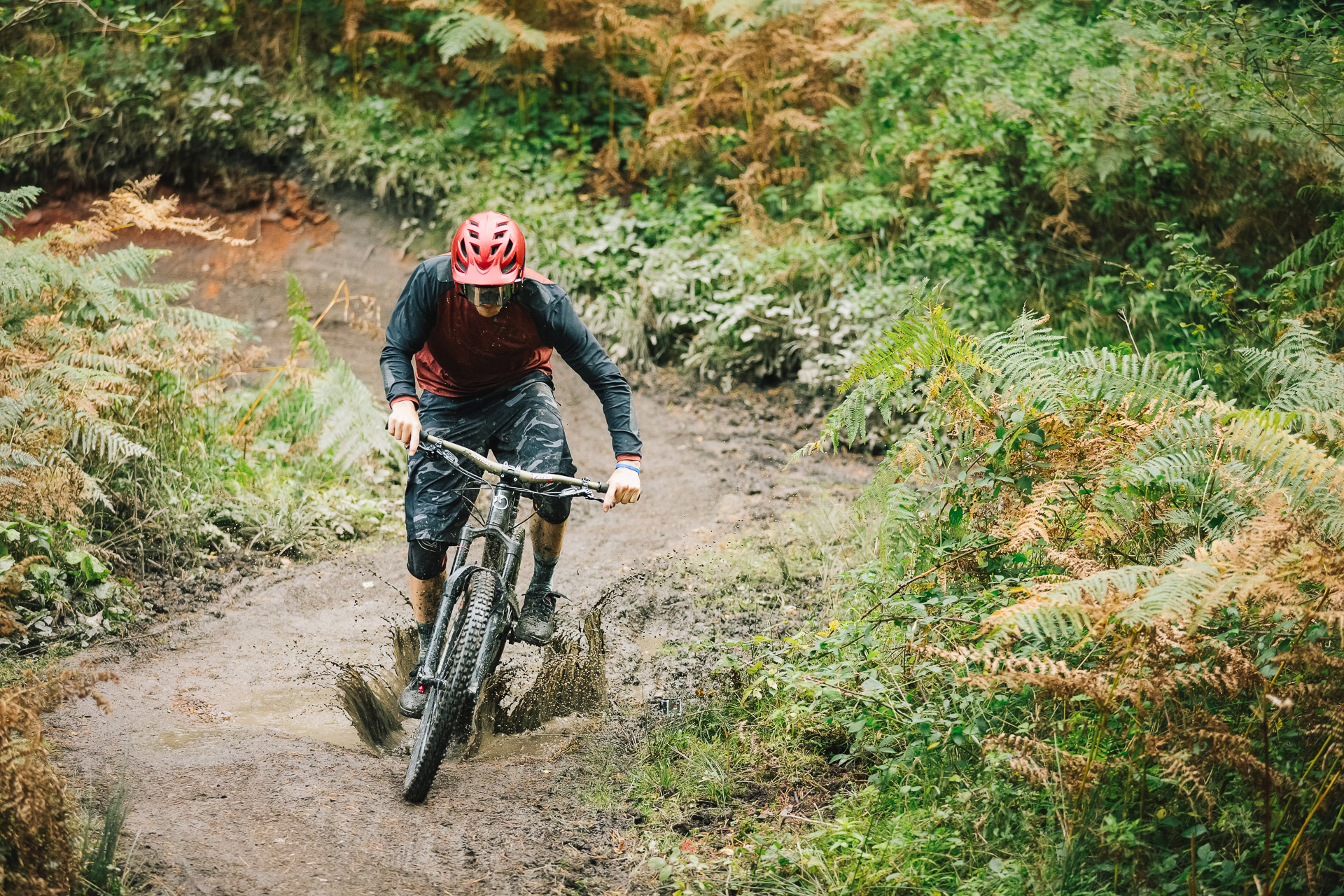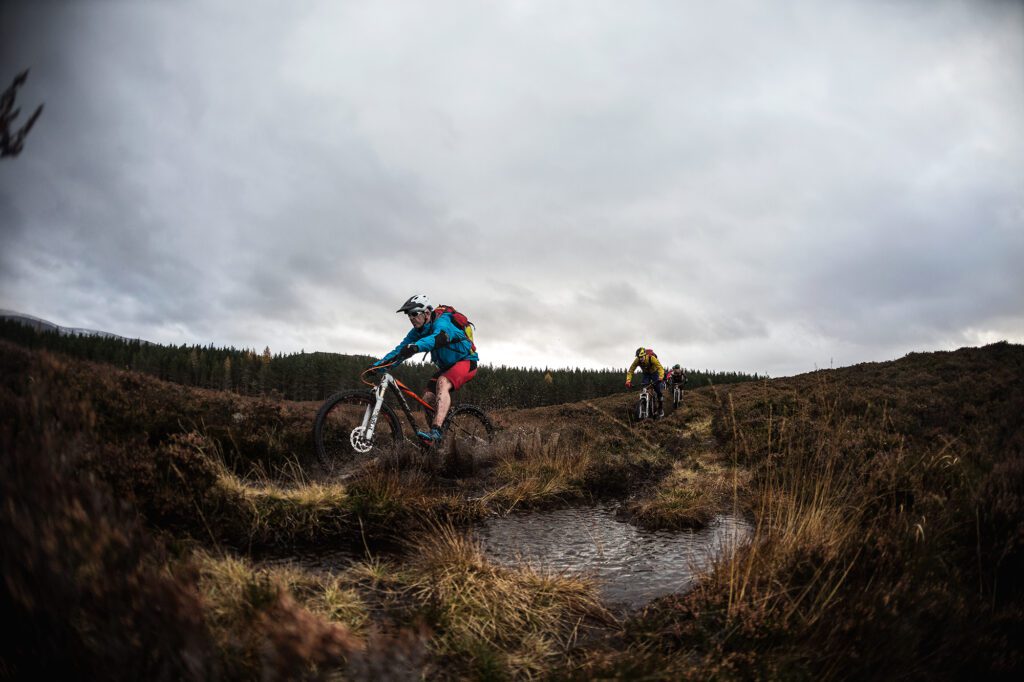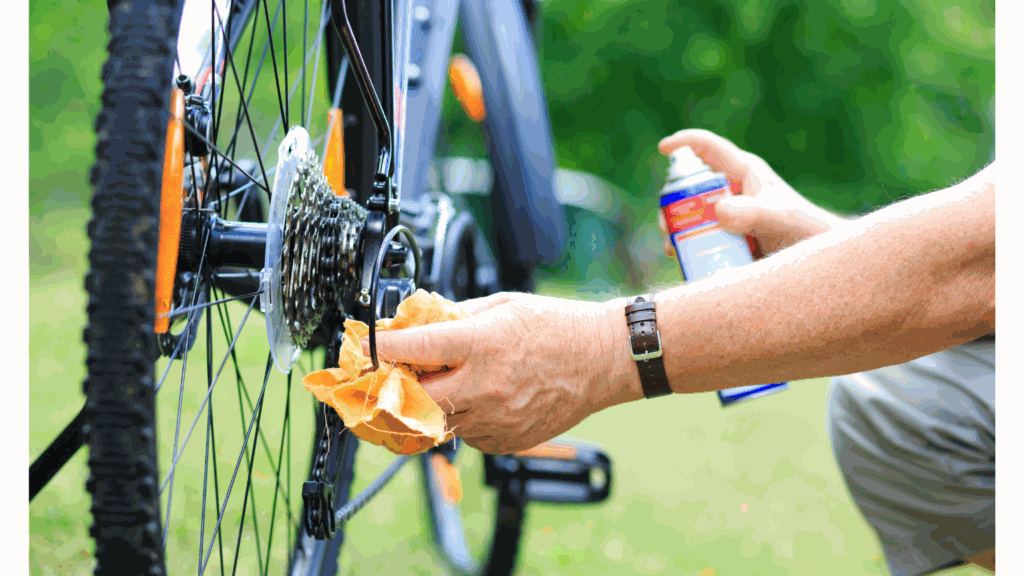


Can you ride a mountain bike in the rain? Answer Yes! While some prefer to stay indoors when it rains, mountain biking in the rain can be a fun and unique experience. However, it is important to take certain precautions and make the necessary adjustments to ensure your safety and keep your bike in good condition.
Read More : ” Can You Mountain Bike Without Suspension? “
Grip and control are everything when mountain biking in the rain. Wet surfaces can be slippery so it is important to have tires with adequate tread and consider using special wet weather tires to increase traction.
Also, changing your driving style to be more careful and avoid sudden maneuvers can help you maintain control on slippery roads.
Braking and stopping in wet conditions also require special attention. Longer stopping distances mean you need more time and space to stop safely. Brake slowly and gradually to avoid skidding and apply proper braking technique.
Before you hit the road, make sure your brakes are working properly by checking and making any necessary adjustments.
Don’t forget to show your bike a little more love after riding in the rain. Riding in the rain exposes your bike to moisture, dirt, and debris, which can cause rust and damage if not properly maintained.
It is very important to thoroughly clean and dry the bike after each ride. Pay particular attention to the chain, transmission, and suspension components as they are more susceptible to wear and corrosion.
Finally, don’t forget to protect yourself from the weather. Wear suitable clothing to stay comfortable and dry during your trip. Consider purchasing waterproof or waterproof clothing such as helmet covers and shoe covers to protect you from the rain.
So if you’re up for the challenge and have the right gear, mountain biking in the rain can be a fun experience. Remember to prioritize safety, evaluate trail conditions, and adapt your driving technique. Feel the thrill of wet terrain and enjoy the unique adventure of riding rain.
Read More : ” Is Front Suspension Necessary On A Hybrid Bike? “
Riding in the Rain: Embracing the Wet Adventure



Mountain biking in the rain can be an exciting and challenging experience. Although it requires a few extra measurements and adjustments, it opens the doors to a whole new world of adventure.
Read More : ” Why Are Full Suspension Bikes So Expensive? “
Here are some key points to consider when riding in the rain:
Adherence and adhesion:
- Wet roads can be slippery, so choose tires with good traction for extra grip.
- Lowering the tire pressure a little can increase traction and help with better control.
Braking technology:
- Brake slowly and gradually to avoid skidding.
- Use the front and rear brakes evenly for effective stopping power.
Driving style adjustment:
- To navigate wet and muddy roads, slow down and maintain a more controlled speed.
- Keep a safe distance from other drivers to avoid accidents due to reduced visibility.
Bike maintenance:
- Clean and dry your bike thoroughly after each wet ride to prevent rust and corrosion.
- Lubricate the transmission and other moving parts to avoid moisture-related problems.
Security equipment:
- Wear appropriate waterproof clothing to stay dry and comfortable while riding.
- Use fenders or fenders to minimize splashing and splashing mud.
Remember that safety should always be a priority. If the weather conditions become extreme or dangerous, it is best to postpone the trip. Experience the thrill of riding in the rain while paying attention to the added challenges the rain presents.
Read More : ” Which Cycle Is Best For Mountain? “
Embrace the wet adventure and create unforgettable memories on your mountain bike.
Traction and Control: Ensuring Grip on Rainy Trails



Mountain biking in the rain can be exciting and challenging. However, wet and slippery conditions require special attention to maintain traction and control. Here are a few key points to help ensure grip in the wet:
Read More : ” Is Downhill Mountain Biking Dangerous? “
Tire selection:
- Choose tires with a tread pattern that performs well in the wet, such as deeper lugs or sipes.
- Consider using a tire with a softer rubber compound for better grip on wet surfaces.
Tire pressure :
- Slightly reduce tire pressure to increase tire contact with the ground, thereby increasing traction.
- However, be careful not to go too low to avoid pinching or damaging the tire.
Hull position:
- Shift your weight slightly back to increase rear traction and prevent front wheel washout.
- Keep your elbows and knees slightly bent to cushion the impact and maintain stability.
Brake technology:
- Brake carefully and gradually to avoid skidding.
- Use a balanced braking technique using front and rear brakes to maximize control.
Transformation:
- Approach turns carefully, using speed and using wider lines to maintain stability.
- Lean the bike into the turn, keeping your body straight for better balance.
Be careful with roots and stones:
- Wet roads can make roots and rocks even more slippery, so approach them with care.
- Slow down, keep your bike light, and avoid sudden movements when overcoming obstacles.
Bike maintenance:
- Wash and dry your bike thoroughly after every ride in the rain to prevent dirt and grime from building up.
- Check and replace worn brake pads regularly for optimal braking performance.
By paying attention to these points and adjusting your riding technique, you will be able to confidently tackle wet trails with better grip and control. Remember to always put safety first and ride according to your skill level.
Enjoy the thrill of riding in the rain while maintaining the safety and control of your mountain bike.
Braking Techniques: Stopping Safely in Wet Conditions



When riding a mountain bike in wet conditions, it is essential to master proper braking techniques to stop safely and maintain control. The following points will help you move safely on wet ground:
Read More : ” Why Are Mountain Bikes Heavier Than Road Bikes? “
Brake Modulation:
- Apply the brakes gradually and softly to prevent sudden locking and skidding.
- Release the brakes by periodically releasing and reapplying for better control.
Failure Distribution:
- Use both the front and rear brakes, but remember that the front brakes provide most of the braking force.
- Adjust the rear weight distribution slightly to prevent the front wheels from spinning.
Early Braking:
- Start braking earlier to ensure longer stopping distances on wet surfaces.
- Remember that wet conditions reduce drag, requiring more time to slow down or stop.
Using the engine brake:
- Shift to a lower gear and rely on the transmission resistor to assist braking.
- Engine braking helps control speed by reducing reliance on brakes.
Keep pace with:
- Maintain momentum in sections to minimize the need for hard braking.
- Anticipate and anticipate obstacles or turns to effectively plan your braking strategy.
Choose a smoother line:
- Whenever possible, choose smoother, straighter lines, as sudden changes in direction can make you lose interest.
- Avoid braking when cornering to prevent the tire from slipping.
Brake Inspection and Maintenance:
- Check and replace worn brake pads regularly for optimum braking performance.
- Keep the brake system clean and free of debris that could affect performance.
Remember that wet weather requires longer braking distances and slower speeds. Practice these techniques in a controlled environment before you go the hard way. With proper braking technique, you can ride safely and confidently in wet conditions and still enjoy mountain biking.
Bike Maintenance: Keeping Your Bike in Top Shape After Riding in the Rain



Riding a mountain bike in the rain is great fun, but it can also expose the bike to elements such as water, dirt, and mud. To keep your bike in top condition and continue to perform at its best, here are some basic maintenance tips to follow after riding in the rain:
Read More : ” How Does Mountain Bike Suspension work? “
Bike cleaning:
- Start by thoroughly cleaning your bike to remove any dirt, grime, and debris that may have accumulated during your ride.
- Use a mild bicycle cleaner, water, and a soft brush or sponge to clean the frame, drivetrain, and other components.
- Pay special attention to places where dirt and water can collect, such as forks, bottom brackets, and forks.
Dries well:
- After cleaning, make sure the bike is completely dry to prevent corrosion and rust.
- Use a clean towel or rag to remove excess moisture from the frame, components, and transmission.
- Let the bike dry in a well-ventilated area, or use a fan to speed up the drying process.
Lubricate moving parts:
- When the bike is dry, apply a fresh coat of oil to the chain, derailleur, and other moving parts.
- Choose a wet or all-weather lubricant designed to retain water and provide long-term protection.
- Wipe off excess lubricant to prevent the suction of dirt and debris.
Check and adjust brakes:
- Check brake pad wear and replace it if necessary.
- Make sure the brake calipers are properly centered and aligned for optimal braking performance.
- Check your brakes to make sure they are working properly and efficiently.
Tire check and inflation:
- Check your tires for signs of damage or injury from driving on wet or muddy roads.
- Inflate your tires to the recommended pressure because you may lose air while driving.
Hold Suspend:
- If your bike is suspension, clean and dry the suspension fork and rear shock.
- Check for signs of moisture or water intrusion and treat immediately.
Store your bike properly:
- Once your bike is clean and dry, store it in a cool, dry place to avoid further exposure to moisture and dampness.
- Consider using a bike cover or storing it indoors to protect it from the weather.
By following these maintenance tips, you can keep your bike in top condition even after riding in the rain. Regular cleaning and maintenance will prolong the life of your bike and ensure it performs at its best on your next ride.
Dressing for the Elements: Staying Comfortable and Dry in Wet Weather



When it comes to mountain biking in wet weather, the right clothing is essential to keep you comfortable and dry throughout the ride. Here are some important tips for clothing for the elements:
Read More : ” Can Bike Riding Cause Prostate Problems? “
Waterproof and breathable outer layer:
- Buy a high-quality, water-resistant, and breathable cycling jacket that will protect you from the rain and prevent sweat and moisture build-up.
- Look for a jacket made of Gore-Tex or similar waterproof material that is water-resistant and breathable.
Moisturizing base coat:
- Wear a moisturizing inner layer that wicks sweat away from your skin and helps regulate body temperature.
- Avoid cotton because it holds moisture, which can make you feel cold and uncomfortable.
Waterproof shorts or pants:
- Consider wearing waterproof shorts or pants to protect your lower body from rain and splashes.
- Look for options with closed seams and adjustable cuffs to keep water out.
Waterproof overshoes:
- Keep your feet dry by wearing overshoes or waterproof overshoes.
- These covers are worn over cycling shoes and provide additional protection against rain and splashes.
Waterproof gloves and socks:
- Wear waterproof gloves to keep your hands dry and grip the steering wheel well.
- Remember to wear waterproof socks to prevent water from seeping into your shoes.
Eye protection:
- Remember to protect your eyes from rain, dirt, and grime by wearing cycling goggles or goggles with clear or tinted lenses.
- Choose from anti-fog options for clear vision in wet conditions.
Hat and Helmet Covers:
- Wear a cycling cap or headband under your helmet to protect your face from the rain and keep you warm.
- Consider using a waterproof helmet cover to protect your head and helmet from rain.
Be sure to tailor your clothing choices to the heat and intensity of your trip. Layering allows clothing to be adjusted as needed to maintain a comfortable body temperature. Also, always take a small, compact raincoat with you in case the weather changes unexpectedly during your trip.
By dressing appropriately in wet weather, you can ride a mountain bike comfortably and stay dry even in harsh conditions.
Pros and Cons of riding a mountain bike in the rain:
Riding a mountain bike in the rain can be an exhilarating and unique experience. While it comes with its own set of challenges, it also offers some distinct advantages. In this article, we will explore the pros and cons of riding a mountain bike in the rain, helping you make an informed decision about whether to embrace the wet adventure.
Pros:
- Increased challenge and skill development.
- Fewer crowds on the trails.
- Refreshing and exhilarating experience.
- Improved traction on certain terrains.
Cons:
- Reduced visibility and potential hazards.
- Increased risk of accidents and injuries.
- More wear and tear on bike components.
- Difficulty in maintaining control and stability on slippery surfaces.
Riding a mountain bike in the rain offers a unique and thrilling experience, but it also comes with its share of challenges. It is important to weigh the pros and cons before venturing out. If you choose to ride in wet conditions, ensure you have the necessary skills, proper safety equipment, and maintain your bike regularly to mitigate any risks.
Remember to prioritize safety and enjoy the adventure responsibly.
Conclusion:
In conclusion, the answer to the question, “Can you ride a mountain bike in the rain?” is a resounding yes. While cycling in the rain can be challenging, with proper preparation and precautions, it is possible to mountain bike even in the rain.
By following the above tips and tricks, such as maintaining good traction, using proper braking techniques, proper bike care, and dressing for the weather, you can ensure safe and enjoyable mountain biking in all weather conditions.
So don’t let a little rain distract you from cycling. Take part in wet adventures, think about safety, and take steps to feel comfortable and prepared. With the right equipment, technique, and mindset, you can mountain bike safely in the rain and get the most out of any trail, in any weather.
So grab your bike, gear up, and get ready to experience the thrill of riding in the rain!
Remember that riding in the rain can be a fun and unique experience, but always put safety first and adapt your riding style accordingly. Happy driving on rainy roads!
FAQs:
Is it OK to get a mountain bike wet?
Yes, it is generally okay to get a mountain bike wet. However, proper maintenance and care are important to prevent rust and damage to the components.
Can I ride my bike in the rain?
Yes, you can ride your bike in the rain as long as you take necessary precautions, such as using fenders, wearing appropriate gear, and being mindful of slippery surfaces.
Is it safe to ride a road bike in the rain?
Yes, it is generally safe to ride a road bike in the rain. However, it is important to exercise caution, maintain a slower speed, and use appropriate tires for better traction.
Does rain damage bikes?
Rain can potentially cause damage to bikes if proper maintenance is not performed. It is important to dry and lubricate the bike after riding in the rain to prevent rust and corrosion.
How do I protect my bike in the rain?
To protect your bike in the rain, use fenders to prevent water splashes, apply a waterproof lubricant to the chain, store it in a dry place, and regularly clean and dry it after rides.



Welcome to Bikegenics, where passion meets performance! We are a leading online destination for all things related to mountain biking, dedicated to providing you with top-notch gear, expert advice, and an immersive community to fuel your two-wheeled adventures. With a commitment to excellence and a deep love for the sport, we strive to elevate your biking experience to new heights.
